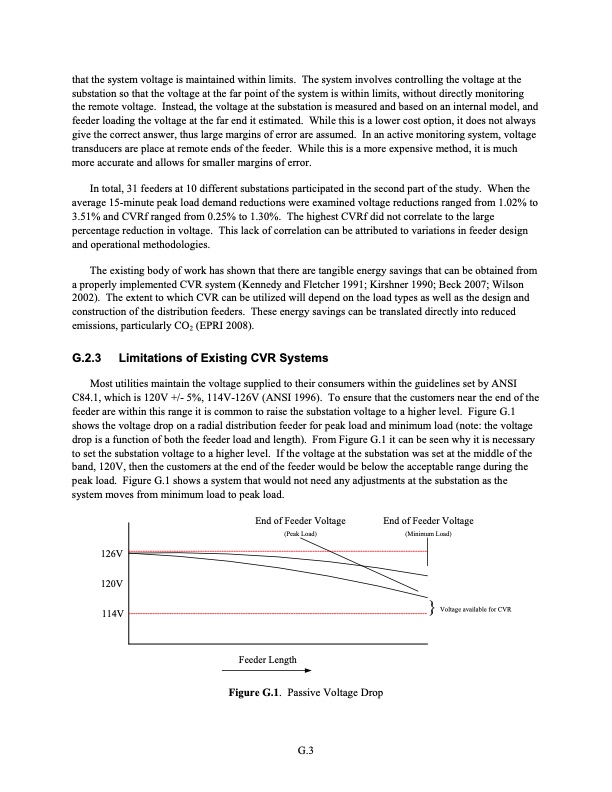
PDF Publication Title:
Text from PDF Page: 129
that the system voltage is maintained within limits. The system involves controlling the voltage at the substation so that the voltage at the far point of the system is within limits, without directly monitoring the remote voltage. Instead, the voltage at the substation is measured and based on an internal model, and feeder loading the voltage at the far end it estimated. While this is a lower cost option, it does not always give the correct answer, thus large margins of error are assumed. In an active monitoring system, voltage transducers are place at remote ends of the feeder. While this is a more expensive method, it is much more accurate and allows for smaller margins of error. In total, 31 feeders at 10 different substations participated in the second part of the study. When the average 15-minute peak load demand reductions were examined voltage reductions ranged from 1.02% to 3.51% and CVRf ranged from 0.25% to 1.30%. The highest CVRf did not correlate to the large percentage reduction in voltage. This lack of correlation can be attributed to variations in feeder design and operational methodologies. The existing body of work has shown that there are tangible energy savings that can be obtained from a properly implemented CVR system (Kennedy and Fletcher 1991; Kirshner 1990; Beck 2007; Wilson 2002). The extent to which CVR can be utilized will depend on the load types as well as the design and construction of the distribution feeders. These energy savings can be translated directly into reduced emissions, particularly CO2 (EPRI 2008). G.2.3 Limitations of Existing CVR Systems Most utilities maintain the voltage supplied to their consumers within the guidelines set by ANSI C84.1, which is 120V +/- 5%, 114V-126V (ANSI 1996). To ensure that the customers near the end of the feeder are within this range it is common to raise the substation voltage to a higher level. Figure G.1 shows the voltage drop on a radial distribution feeder for peak load and minimum load (note: the voltage drop is a function of both the feeder load and length). From Figure G.1 it can be seen why it is necessary to set the substation voltage to a higher level. If the voltage at the substation was set at the middle of the band, 120V, then the customers at the end of the feeder would be below the acceptable range during the peak load. Figure G.1 shows a system that would not need any adjustments at the substation as the system moves from minimum load to peak load. End of Feeder Voltage (Peak Load) End of Feeder Voltage (Minimum Load) } Voltage available for CVR 126V 120V 114V Feeder Length Figure G.1. Passive Voltage Drop G.3PDF Image | The Smart Grid: An Estimation of the Energy and CO2 Benefits

PDF Search Title:
The Smart Grid: An Estimation of the Energy and CO2 BenefitsOriginal File Name Searched:
PNNL-19112.pdfDIY PDF Search: Google It | Yahoo | Bing
NFT (Non Fungible Token): Buy our tech, design, development or system NFT and become part of our tech NFT network... More Info
IT XR Project Redstone NFT Available for Sale: NFT for high tech turbine design with one part 3D printed counter-rotating energy turbine. Be part of the future with this NFT. Can be bought and sold but only one design NFT exists. Royalties go to the developer (Infinity) to keep enhancing design and applications... More Info
Infinity Turbine IT XR Project Redstone Design: NFT for sale... NFT for high tech turbine design with one part 3D printed counter-rotating energy turbine. Includes all rights to this turbine design, including license for Fluid Handling Block I and II for the turbine assembly and housing. The NFT includes the blueprints (cad/cam), revenue streams, and all future development of the IT XR Project Redstone... More Info
Infinity Turbine ROT Radial Outflow Turbine 24 Design and Worldwide Rights: NFT for sale... NFT for the ROT 24 energy turbine. Be part of the future with this NFT. This design can be bought and sold but only one design NFT exists. You may manufacture the unit, or get the revenues from its sale from Infinity Turbine. Royalties go to the developer (Infinity) to keep enhancing design and applications... More Info
Infinity Supercritical CO2 10 Liter Extractor Design and Worldwide Rights: The Infinity Supercritical 10L CO2 extractor is for botanical oil extraction, which is rich in terpenes and can produce shelf ready full spectrum oil. With over 5 years of development, this industry leader mature extractor machine has been sold since 2015 and is part of many profitable businesses. The process can also be used for electrowinning, e-waste recycling, and lithium battery recycling, gold mining electronic wastes, precious metals. CO2 can also be used in a reverse fuel cell with nafion to make a gas-to-liquids fuel, such as methanol, ethanol and butanol or ethylene. Supercritical CO2 has also been used for treating nafion to make it more effective catalyst. This NFT is for the purchase of worldwide rights which includes the design. More Info
NFT (Non Fungible Token): Buy our tech, design, development or system NFT and become part of our tech NFT network... More Info
Infinity Turbine Products: Special for this month, any plans are $10,000 for complete Cad/Cam blueprints. License is for one build. Try before you buy a production license. May pay by Bitcoin or other Crypto. Products Page... More Info
| CONTACT TEL: 608-238-6001 Email: greg@infinityturbine.com | RSS | AMP |